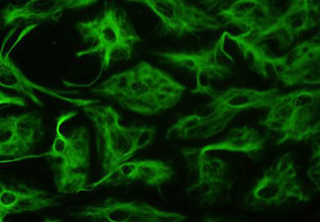
Visualization of astrocytes, the second most common glia in the central nervous system. They are known as key players in neuromodulation, synaptogenesis, myelination and neurogenesis. (Image courtesy of Regina Armstrong, Uniformed Services University of the Health Sciences.)
Instructor(s)
Dr. Bikem Akten
MIT Course Number
7.343
As Taught In
Spring 2007
Level
Undergraduate
Course Description
Course Features
Course Description
The main goal of this seminar will be to study the nervous system from the perspective of neuron-glia interactions. In each class, we will focus on one type of glial cell and discuss its origin, classification and function within the nervous system. Current findings concerning diseases associated with each type of glial cell will be discussed.
This course is one of many Advanced Undergraduate Seminars offered by the Biology Department at MIT. These seminars are tailored for students with an interest in using primary research literature to discuss and learn about current biological research in a highly interactive setting. Many instructors of the Advanced Undergraduate Seminars are postdoctoral scientists with a strong interest in teaching.


